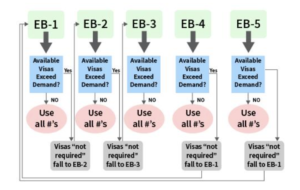After all the work, fees, and filing done for an I-140 approval for the EB-2 green card, you still need to wait for the priority date to be current. For some people, the EB-2 green card waiting time could be several years or far longer. Because the EB-1 waiting times are often much shorter, one thing that many of these prospective green card holders consider is EB-2 to EB-1 porting. Porting is not as simple as it sounds. It essentially involves starting again from scratch while retaining the original priority date. Keep reading to find out what the process is.
EB-2 to EB-1 Green Card Porting
Policy Update- On September 12, 2023 USCIS updated the manual to offer clarifying guidance on examples of evidence that may satisfy the relevant criteria for employment first-based preference applicants, as well as how USCIS officers evaluate the totality of the evidence for eligibility. See the complete details in this EB-1 policy update post.
So now that we know the requirements for obtaining an EB-1 green card, we can dive deeper into EB-2 to EB-1 porting. Remember that just because you feel qualified doesn’t mean the USCIS will accept your petition. Work with an immigration attorney to gather evidence and solidify your case before filing. This process is much more delicate than porting from an EB-3 to an EB-2 green card.
If you already have an I-140 petition approved for an EB-2 green card and are from China or India, you must wait several years before a visa number becomes available. To bypass this wait time, you could conceivably go through EB-2 to EB-1 porting if you qualify.
Learn about the employment adjustment of status process.
EB-2 to EB-1 Porting Process
How do I move to the EB-1 category?
To be eligible for the upgrade, you must demonstrate the necessary qualifications for one of the EB-1 categories and a job that fits these qualifications.
Here is an example:
Rateesh has gotten an approved I-140 for his EB-2 green card as an IT specialist for a multinational company. However, because he is from India, his priority date will not be current for at least twelve years. Although he was a manager in his previous role abroad, he is not currently a manager in the U.S. Subsequenlty, he receives several promotions that land him in a managerial position within the IT company.
In this example, Rateesh might be qualified for EB-2 to EB-1 porting. To do this, he would need to work with his immigration attorney to gather the evidence required to prove his qualifications to the USCIS.
Wondering if you are current? Check the latest Visa Bulletin!
Then, his employer can file a second I-140 under the new EB-1 category. This will allow him to retain his priority date from the first petition. When USCIS approves the new I-140 petition, a visa will become available significantly sooner under the priority dates for the EB-1 green card.

However, there are caveats to the EB-1C green card for multinational managers. One of the main requirements is that the beneficiary must have worked in a managerial or executive capacity for one full year in the three years prior to the initial visa entry into the U.S. This managerial work must have been done at the company’s offshore offices. However, if one never held a manager position abroad and were already in the U.S. under a nonimmigrant visa such as an H-1B or L-1, then one would need to return to the offices abroad to work for one full year as a manager and then re-enter in a similar U.S. manager role before be considered eligible.
Here is another example:
Cindy has a master’s degree in biochemistry and applied for an EB-2 as a research fellow at a prestigious organization. While she was waiting for her priority date to become current, her work was published in several journals, she gained membership into an exclusive organization for biochemists, and her salary increased to the point of being considerable. This may qualify her for the EB-1A green card. Because the EB-1A does not require a PERM nor necessarily an employer sponsor, she may not need to obtain a new job in order to port. She may simply self-petition and file a new I-140 for the EB-1A along with supporting evidence and fees.
Therefore, porting from an EB-2 to an EB-1 green card is like filing for a brand new green card from scratch and keeping your original priority date.
Benefits of EB-1 versus EB-2
There are quite a few advantages of EB1 over EB2, including:
- Typically shorter priority date waiting time
- While the priority dates will change based on the applicant’s country of origin, EB-1 generally has fewer applicants because of the stringent requirements.
- Can waive PERM Labor Certification
- This is not a requirement to qualify for the EB-1, and thus saves valuable time as a result.
- Concurrent filing
- As an EB-1 applicant, you may be able to file the I-140 and I-485 simultaneously, saving processing time.
- Early work authorization for relatives
- If you file the I-140 and I-485 simultaneously, this sets the stage for your spouse and/or children to get work authorization before USCIS approves the green card application.
The main disadvantage is that EB-1A has stricter eligibility requirements, leaving fewer eligible than in other employment green card categories.
Learn about EB-2 green card costs.
Green Card Porting and 180-Day AC-21 Portability Rule
If you lose or change your job after submitting your employment-based green card petition, you may still be able to retain the pending application even if you no longer work for the employer that sponsored the petition.
The 180-day portability rule is part of the American Competitiveness in the 21st Century Act, which became effective on October 17, 2000. Among other things, it addresses the potential hitches that may arise after filing an I-140 form and I-485 green card application, and the applicants are still waiting for their adjustment of status. The rule provides that an approved I-140 petition will remain valid even if the beneficiary changes their job as long as the following conditions are met:
- The I-485, Petition for Adjustment of Status, is filed and has been pending with the USCIS for 180 days or more.
- The new job meets the same or similar occupational classification as the original petition for which the I-140 was initially approved.
How Portability Works
In this section, we’ll look at how portability works after changing a job and more details about the AC-21 Portability Rule.
Portability after changing your job
If you change your job after your employment-based green card petition has been pending for 180 days or more, your application will not be denied based because you changed jobs. However, you must notify the USCIS service center that you no longer intend to work with the employer who sponsored the I-140 petition.
If all portability requirements are met, including the new position is the same or similar occupational classification as the original petition for which the I-140 was approved, then you will likely be approved.
It is also worth noting that even if 180 days haven’t yet passed, you may still be able to attempt portability. However, that will depend on multiple factors including whether the original employer will withdraw the petition before the 180-day point. This has several grey areas and is not as straightforward. It is best to speak to your lawyer if you find yourself in such a scenario.
Learn more about AC-21 Portability Rule.
EB-2 and EB-1 Differences
Do you know the difference between EB-1 and EB-2? Let’s take a look below!
EB-1
- Priority category: EB-1 is a higher priority category compared to EB-2, meaning that there are typically shorter waiting times for visa availability.
- Extraordinary Ability: EB-1 is for individuals with extraordinary ability in sciences, arts, education, business, or athletics.
- Outstanding Professors/Researchers: EB-1B also includes professors and researchers recognized internationally for their outstanding achievements in their respective fields.
- Multinational Managers/Executives: Another subcategory of EB-1C is for multinational executives or managers who have been employed by a foreign company and are being transferred to a related U.S. company.
- No labor certification: EB-1 applicants do not require a labor certification from the U.S. Department of Labor, which is a time-consuming process necessary for many other employment-based visa categories.
EB-2
- Lower priority: EB-2 is lower than EB-1, resulting in longer waiting times for visa availability.
- Advanced Degree Professionals: EB-2 is primarily for professionals with advanced degrees (master’s degrees or higher) or individuals with exceptional ability in the sciences, arts, or business.
- Labor certification: EB-2 applicants must obtain a labor certification from the U.S. Department of Labor, which involves demonstrating that no qualified U.S. workers are available for the position.
- National Interest Waiver (NIW): One significant advantage of EB-2 is the potential to qualify for a National Interest Waiver, which allows individuals to bypass the employer sponsor and labor certification requirements if they can demonstrate that their work is in the national interest of the United States.
- Exceptional ability (no degree required): Besides advanced degree professionals, EB-2 also includes individuals with exceptional ability in their respective fields, although they must still undergo the labor certification process.
It’s important to note that the specific requirements and eligibility criteria for EB-1 and EB-2 visas may vary.
EB-2 Green Card
The EB-2 is designed for people who fall into one of two categories:
- Foreign nationals that have obtained an advanced degree (master’s or higher) in their field.
- Foreign nationals that possess exceptional ability in their field. To prove your ability, you need to submit evidence of at least three of the following requirements:
- A specialized degree relating to your field
- Proof of 10 years of experience in your field
- Any licenses or certifications related to your work
- Command of a substantial salary in your field
- Recognition from your peers or awards
- Membership in an association related to your field
Without a National Interest Waiver (NIW), all EB-2 applicants must have a job offer from a U.S. employer and therefore have that employer acquire a PERM Labor Certification on their behalf. The NIW allows entrepreneurs and practice owners to self-petition for their EB-2 green cards.
To qualify for an NIW, you must demonstrate three things to the USCIS:
- Your work will benefit the culture, society, education, science, technology, or job market of the United States.
- You are uniquely positioned to make your work succeed by showing your education, experience, past successes, or current progress.
- The U.S. would benefit more from waiving the PERM requirement for you than it would by enforcing it. This last item is essential since the PERM stands to protect U.S. workers.
EB-1 Green Card
The EB-1 is the most coveted employment-based green card available. It typically has little to no priority date wait times, and applicants for the EB-1 visa do not need a PERM Labor Certification. However, there are times when a backlog builds up and wait times increase. Here are the three categories of EB-1 green cards.
EB-1A
This category is for foreign nationals with extraordinary achievements in science, business, education, art, and athletics. These achievements can come as a globally recognized award such as the Nobel Prize or three of the following types of forms:
-
- Nationally or internationally recognized awards in your field
- Being a member of an organization in your area that requires extraordinary achievement for entry
- Having media or journal publications recognize your work
- Publishing your work in scholarly articles or professional journals
- Having made significant contributions to your field
- Having your work displayed at an exhibition
- Retaining an impacting role in an association or organization that has a reputation in your field
- Commanding a large salary that distinguishes you in the field
EB-1B
This category is for outstanding researchers and professors. To qualify, you must:
-
- Have at least three years of experience teaching or researching in your field
- You have been offered tenure or a research position that does not have a fixed term
- International recognition in your academic field
EB-1C
This category is reserved for executives and managers.
-
- To qualify as a manager, you must meet these requirements:
- You must manage a function, component, or function of the organization
- As a manager, you must be able to supervise the work of subordinates and can fire and hire them
- You must be able to control daily activities and tasks
- To qualify as an executive, you must fulfill the following requirements:
- Control managers in the organization
- Create plans and goals
- Be able to make far-reaching decisions without supervision
- The employer must also meet some requirements:
- It must be a multinational U.S. organization with a branch, subsidiary, or affiliate in a foreign country
- The employer must also have been doing business in the U.S. for at least a year before filing the petition
- Additionally, you must have been employed outside the United States in the three years preceding the initial U.S. entry for at least one year by a firm or corporation. You must seek to enter the United States to continue service to that firm or organization. Your employment must have been outside the United States in a managerial or executive capacity and with the same employer, an affiliate, or a subsidiary of the employer.
- To qualify as a manager, you must meet these requirements:
Things to Remember Before Attempting to Port
- The EB-1A does not require an employer sponsor or a PERM Labor Certification.
- The EB-1B and EB-1C also do not require a PERM but do require a job offer by a U.S. employer.
- The premium processing service is now available for all EB-1 categories.
EB-2 vs EB-1 Fees
-
Filing Fees: The I‑140 filing fee is the same for both EB‑1 and EB‑2 petitions. $715
-
PERM Costs: EB‑2 (without NIW) incurs additional costs for labor certification, which do not apply to EB‑1 cases.
-
Premium Processing & I‑485: These fees are generally similar across both categories if premium processing is used and if adjustment of status is pursued. $1,440
-
Attorney Fees: These may be higher for EB‑1 cases that require extensive evidence for extraordinary ability or similar criteria, though EB‑2 PERM cases incur extra costs from the recruitment process.
How the Priority Dates Work
For all green cards, you or your sponsor must file an immigrant visa petition (I-140). When the USCIS receives your petition, that filing date will become your priority date or the related PERM Labor Certification filing date depending on the type of I-140 filed. The Department of State releases final action dates each month in its visa bulletin.
When your priority date matches or passes the final action date in your country and category, your date will be considered “current,” and a “visa number will become available. You will then be able to submit an I-485 to change your status to Permanent Resident.
The primary benefit of EB-2 to EB-1 porting is to reduce the time you need to wait for your priority date to be current. The usual advantage of applying for an EB-1 is that all dates are current or will be current sooner, no matter which country you were born in. That means you can adjust your status without waiting as soon as your I-140 is approved. You may even file both the I-485 and I-140 concurrently under the correct circumstances.
Frequently Asked Questions
Have a question related to EB-2 to EB-1 porting? We may have an answer below! It’s highly advised to consult your immigration attorney for the most case-specific and up-to-date answers regarding your employment visa.
Can the EB-2 priority date be ported to EB-1?
Yes, EB-2 can be ported to EB-1. The first step is for your immigration attorney to assess your eligibility. EB-1 is typically reserved for individuals with extraordinary ability, outstanding professors/researchers, or multinational managers/executives. You and your attorney will then collect supporting documents and evidence that demonstrate your eligibility for EB-1. This may include documentation of your extraordinary abilities, international recognition, significant contributions, awards, publications, patents, media coverage, membership in prestigious organizations, and expert testimonials. When it comes time to prepare your petition, your attorney will organize your evidence, draft a comprehensive cover letter, and complete the required USCIS forms.
Submit the completed petition, the required supporting documents, and filing fees to the appropriate USCIS service center. USCIS will review your petition and supporting documents. They may request additional evidence or schedule an interview to evaluate your qualifications further. You will receive an approval notice indicating your new EB-1 classification if your petition is approved. If denied, you may have options for reconsideration or appeal, depending on the specific circumstances.

Is EB-1 faster than EB-2?
Generally, yes it’s a shorter priority date waiting period.
Was your green card denied? Check out this complete guide on Green Card Denial.
How is the 180-day period counted?
The 180-day rule under the AC21 Act is governed by the receipt date of the I-485 application. The counting will start from the date your I-485 was received by the USCIS and not the date when they generated the receipt of notice.
What if there are some differences in the occupational classification?
One of the significant rules of porting from one employer to another is to have the same or similar occupational classification. However, if the jobs differ, your green card application can still be processed if the differences are minor.
The language used in the AC21 Act is “same or similar.” In this case, the USCIS will use the DOL’s classification, which is generally broad. It also considers other factors such as the job duties, skills, experience, certification, education, and licenses required for the new job. As long as there are similarities in these areas, the few differences will not matter.
What if a salary difference exists between the former and the new job offer?
While salary is essential in all employment-based visa applications, that doesn’t mean every employer should offer the same wages for the same or similar job offer. Therefore, the difference in pay will not necessarily affect your ability to port as long as the occupational classification is similar or the same.
Though the USCIS may review the salary difference, the review will only be based on the gap size, as a significant gap may indicate that the job classification is not similar enough. It is also worth noting that the large salary criteria for the EB-1A green card, for instance, is just one of the eligibility criteria, and you only need to meet at least three out of the ten listed requirements. Your immigration lawyer will be in the best position to guide you on this.
Can a difference in geographical location affect green card portability?
This is unlikely as the new job offer does not have to be in the same location as the one in the original I-140 petition.
What if I have never worked for the employer?
Even if you have never been employed by the employer who sponsored the petition, your green card application will not be denied based solely on that. However, this could cast doubt on whether the original job offer from the employer was bona fide.
If you are in this scenario, be ready to provide evidence showing that the job offer was genuine and the employer intended to hire you.
Is EB1 or EB2 green card processing time faster?
Usually, the EB2 processing time will take longer because you need a Labor Certification. And for those whose country of origin is India or China, the high demand in these countries means longer processing.
Has USCIS taken any steps to use the available employment-based visas better?
The agency has come out and said they have taken numerous steps and initiatives to use the visas available including prioritizing the processing of adjustment of status applications, applying risk-based filters to adjudicate more applications without needing to conduct an interview, working alongside DOS to positively affect the dates in the visa bulletin through the flow of filing and adjudicating applications, compensating USCIS officials who work overtime and supplementing staff, etc.
What status do I need for work authorization while I port my pending green card application?
This will depend on your current nonimmigrant status in the U.S. If you are on H-1B status, the new employer can file an H-1B visa extension for you. This can be achieved even after your six years of H-1B period of stay is exhausted. Immigration law permits H-1B holders waiting for a green card to extend their stay beyond the six-year limitation under certain circumstances.
If you are on another nonimmigrant work visa, you may need to request an employment authorization document (EAD) card. And if you have an existing EAD that is about to expire, you must request an extension of the card before the expiration date.
If immigrant visas aren’t available, do they get added to a different category?
Congress has set it up so that there are “Fall Down/Fall Up” provisions in employment-based categories and that unreserved visas not required in EB-4 and EB-5 are available in EB-1. Visas not required in EB-1 are made available in EB-2, and visas not required in EB-2 are made available in EB-3. Look at the graph below for a clear depiction.

How can I travel with my green card?
While you can travel in and out of the United States under green card status, you must be aware of potential complications if certain factors are not considered before departing. Learn more about traveling with a Green Card.










